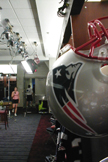
Pic #1: Click to Enlarge
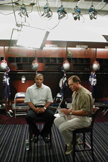
Pic #2: Click to Enlarge
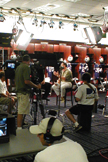
Pic #3: Click to Enlarge
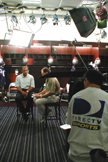
Pic #4: Click to Enlarge
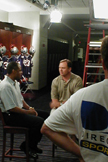
Pic #5: Click to Enlarge
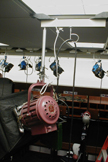
Pic #6: Click to Enlarge

Pic #7: Click to Enlarge

Pic #8: Click to Enlarge
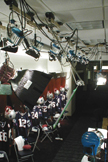
Pic #9: Click to Enlarge
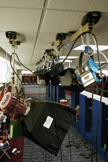
Pic #10: Click to Enlarge
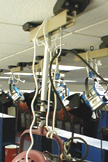
Pic #11: Click to Enlarge

Pic #12: Click to Enlarge
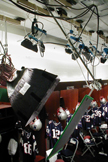
Pic #13: Click to Enlarge
DirecTV Sports' NFL Preview 2002
We showcase this production for DirecTV Sports because it clearly demonstrates why the Porta-Grid System is the best production tool you can have when shooting under drop ceilings. Though long in detail, the following explanation is sure to reward you with a wealth of insight into how to achieve the best lighting you can when shooting under drop-ceilings. It also reminds us that sometimes a little thing, like a light hanger, can make a big difference in a production.
But first a humorous and informative anecdote. There is a story going around the International Film & Television Workshops in Rockport, ME, about a student that not only put his foot in his mouth, but also swallowed it whole. One year, according to this story, the arrival of the instructor for the week long Film Lighting Workshop was delayed and he missed the opening introductions. By the time he arrived, the class had already broken up into smaller production units and had begun their first lighting exercise. For those not familiar with the Film Workshops, each student takes a turn, in the lighting exercises, directing the rest of the unit in the lighting of a scene.
In one unit, the student whose turn it was to serve as D.P. was positioning the key light on a stand when a suggestion was made by someone that he move the light six inches to the left and go down on the stand another six inches. When the student D.P. failed to move the light, the one that had made the suggestion moved the light himself, saying "look what happens when you move the key just this much." The student D.P. didn't appreciate being told what to do during his turn to direct the class exercise, so he promptly moved the light back to where he had it and retorted "that's all right, I prefer it where it was." To which the other responded "but wait, look what happens when you move the key just this much" and he moved it the six inches back again, but held onto the stand this time. The student D.P. became quite irritated and grabbed at the light stand as well, saying "You can put the light anywhere you like when its your turn, but I'll put the light where I want it." It was at this point that the course assistant put an end to the argument over the light stand by introducing the student D.P. to the other gentleman holding the stand as his instructor - Laszlo Kovacs, ASC. I like this story because it not only demonstrates the conceit of some Film Workshop students, but also that a few inches in the placement of a light can make such a big difference that it is worth fighting for.
For example, sometimes lowering the key light just a few inches can make the difference between putting a sparkle in the eyes - the "windows of the soul"-- or a raccoon's band of shadow around the eye sockets. Likewise, moving the key light just a few inches around behind and down will merge the nose and cheek shadows to create a pleasing triangle of light in the eye socket, opposite the key, called Rembrandt's triangle. And to be certain, moving a kicker just a few inches too far around front can turn a pleasing accentuation of the jaw line into a nasty highlight on the tip of the nose. Without a doubt lighting is, as Vince Lombardi once said about football, "a game of inches". And, one of the biggest challenges in lighting, without a doubt, is to get a light exactly where it needs to be to create the optimum effect without the light or its' stand appearing in the shot.
On locations with drop ceilings, rigging lights can be much simplified by the Porta-Grid System. The innovative design of the Porta-Grid System offers you the flexibility and control you need to position a light where ever it is required for optimum effect, whether it is above or below the drop-ceiling. In fact, it can turn an ordinary drop ceiling into a full blown studio grid.
The cornerstone of this revolutionary new approach to lighting under drop-ceilings is the Porta-Grid Clamp. The clamp consists of an extremely lightweight fiberglass I-Beam track between two fiberglass mounting brackets with scissor clips on each end. The scissor clips are spaced 2' apart so that they can mount directly to standard drop-ceiling "T" channel spaced to support the most common 2'x 2' and 2'x 4' ceiling tiles. Once rigged to the drop-ceiling grid, the Porta-Grid Clamp can slide on the ceiling's "T" channel, enabling you to make broad adjustments in light placement on one horizontal axis. While, the Porta-Grid Light Mount can slide in the clamp's channel, enabling you to make adjustments in light placement on the other horizontal axis. In this fashion, you can position a light anywhere between the drop ceiling "T" channel grid parallels, and are not restricted to them the way you are with scissor clips with studs. The Porta-Grid Clamp can also be rigged so that the light hangs below the ceiling, or so that the light sits above the ceiling. It also accepts a large assortment of drop-down extensions and risers so that a light can be rigged at whatever height is required for optimum effect, whether it is above or below the drop-ceiling. Thus, the Porta-Grid System offers you the capability to position a light where ever it is required for optimum effect.
The production pictured here, for DirecTV Sports, clearly demonstrates both the control, as well as the flexibility, of the Porta-Grid System when it comes to rigging lights for optimum effect. To be certain, the biggest challenge in lighting this production of DirecTV's NFL Preview for 2002 would have been the positioning of two key lights if it were not for the versatility of the Porta-Grid System. But first, let's look at the Director of Photography's vision for this show and the obstacles the location presented to achieving it.
As you can see in picture # 2 at left, the show features two sports commentators, discussing the prospects for the upcoming season. It is shot with two cameras. A center camera frames a two shot of the commentators sitting almost opposite each other, but turned slightly toward that camera (picture #3). For close-ups, a second camera was positioned to the right of center to shoot a single of the commentator on the left (picture #4); while the center camera can punch in for a single of the commentator on the right. Given this blocking of camera and talent, Jim O'Donnell, the D.P., wanted to use the classic studio approach of reverse cross keys so that the lighting wouldn't appear flat to either camera position.
In reverse cross key lighting, two key lights are positioned on the opposite side of the talent from the center camera position so that they cross. In these positions the keys are not flat to either camera. The center camera, in the two shot, records a full range of light and shadow as it shoots into the down side of the talent's face in near profile. The shot, however, does not appear flat and under lit because the reverse key, if placed precisely, will break over the nose and highlight the talents' eyes with the pleasing Rembrandt's triangle of light mentioned earlier. Though not shot from the center camera position, you can begin to see the modeling of the Rembrandt's triangle in picture #5 at left. The right camera, on the other hand, shoots the talent square on in the single of the left commentator. To this camera position, the lighting is full, but not flat, because what was a reverse key in the two shot from the center position, becomes a quarter frontal key in the single from the right camera position (as can been seen in picture #4 at left). In addition, to creating a full and pleasing contrast range to each camera position, this lighting approach offers the added advantage that each key also serves as a backlight for the talent that it is not keying (as can been seen also in picture #4 at left)..
Though this is a classic studio approach to lighting a two shot for two cameras, it can be a real challenge on location because the keys, which also serve as backlights, have to be rigged - otherwise their stands would appear squarely behind each of the talent in their close-ups. On this location, reverse cross key lighting would have been impossible, were it not for the versatility of the Porta-Grid System. It would be hard because the locker room of the New England Patriots has a 14'drop ceiling; but, Jim O'Donnell, the Director of Photography, only made it harder when he said he wanted to key with babies through Chimera Banks.
Traditional scissor clips with studs would not have worked very well under these circumstances. Rigged directly to the drop ceiling grid with scissor clips, the keys would have been too high to dig light into the eyes of the seated talent. It also would have been impossible to focus them because a scissor clip would have buckled under the unbalanced load of a light with a Chimera Bank on the front. To make matters worse, it was impossible to rig to structural supports above the ceiling because there was, either, simply nothing to rig to where the lights had to go; or there were obstacles, such as recessed fluorescent banks, in the way. Under these circumstances it would have been impossible to give the Director of Photography the reverse cross keys he wanted with traditional rigging hardware.
Without a doubt, having the right tool - like a hammer to drive a nail - can make an impossible task easy. Likewise, the Porta-Grid Clamp can make the impossible possible. For example, the clamp made it easy for us to overcome the obstacles that confronted us here and give Jim the studio style reverse cross key lighting that he envisioned for the show.
How? First, because it attaches directly to the drop ceiling "T"channel grid, and is not dependent on rigging points above the ceiling to hang a light, the Porta-Grid Clamp enabled us to rig a light precisely where required - even directly under a fluorescent bank (picture #6). Second, the Porta-Grid's accessory Baby Drop Down Extension enabled us to hang the keys at the optimum height so that the light would dig into the eyes of the seated talent (pictures 6 & 7). Offering studio control on locations with drop ceilings, the Porta-Grid System enabled us to easily overcome the obstacles presented by this location and rig the babies precisely where they were needed, and at the exact height required, to create the Rembrandt's triangles that Jim was looking for in the two shot.
Another example of the studio control that the Porta-Grid system offers on locations with drop ceilings, was the capability it gave us to quickly rig a back rim light (picture #8) . With reverse cross key lighting, when the talent on the right turns squarely to the center camera for his close-up, the cross key on the right, which was his backlight, now becomes a kicker. To separate him from the background in his close-up it was decided, at the last minute, that he should have an additional back rim light. Fortunately, the versatility of the Porta-Grid Clamp enabled us to quickly and easily rig a light directly behind the talent so that it would serve as a true back light and not as an additional kicker. The Porta-Grid Baby Drop Down Extension enabled us to easily adjust the height of the light so that is was a true rim light and not too toppy. To be certain, we could never have accomplished such precise placement of a back rim light, as quickly as we did, if it were not for the studio control that the Porta-Grid system offers on locations with drop ceilings.
This production also demonstrates how the flexibility of the Porta-Grid System can be a real life saver as well. As is often the case, this production for DirecTV was run like a three ring circus. The production schedule called for the grip and electric crew to simultaneously be shooting on one location, while wrapping the previous location and prelighting the next location. Even though it was likely that things would change once the cameras and talent came on set, we never the less established, at the outset, rough marks for the talent positions so that we could prelight the locker room. Sure enough, when the cameras arrived on set, it was determined that the talent marks had to be rotated counter clockwise in order to get the desired background from each camera position. Unfortunately, this meant that the position of the keys and backlights also had to be rotated. To make matters worse, by the time the shooting crew arrived on set, the production was behind schedule, and faced a hard out on one of the talent. The Assistant Director didn't help matters by declaring that any final tweaking of lights had to be done quickly or not at all.
Under these circumstances, we would have had to leave well enough alone, and forsaken the finer nuances of reverse cross key lighting, if it were not for the tremendous flexibility of the Porta-Grid System. Even after it is rigged to the drop-ceiling grid, the Porta-Grid Clamp can slide on the ceiling's "T" channel, enabling you to quickly make broad adjustments in light placement on one horizontal axis. While, the Porta-Grid Light Mount can slide in the clamp's channel, enabling you to make adjustments in light placement on the other horizontal axis. Given such flexibility we were able to quickly make the necessary changes in light placement without having to bust the rigs, and start all over again - which was a show saver.
Once we were roughed in again for the new talent positions, the flexibility of the Porta-Grid System also enabled us to quickly fine tune the lights to get the desired effect out of the reverse cross keys. We easily slid the whole clamp further on the drop ceiling grid so that the key position was a little further back. We also slid the Porta-Grid Baby Drop Down Extension in the Porta-Grid's channel so that the key position was a little further behind. And finally, to create the desired Rembrandt's triangle of light in the eye socket, we were able to easily adjust the height of each key with the Porta Grid Baby Drop Down Extension. To be certain, we could never have reset as quickly as we did if it were not for the tremendous flexibility that the Porta-Grid system offers.
In fact, the Porta-Grid system worked so well under these circumstances that, as you can see in picture #9, we ended up using fifteen of them to rig everything from multiple keys and back lights, to numerous specials on the players' game jerseys. The clamp was even solid enough that we could offset a large net, at the end of a 40" grip arm, to cut the backlight on one of the talent. To be sure, none of this would have been possible if it were not for the fact that the Porta-Grid System is a safer means of rigging to drop-ceilings than has ever existed before.
Part of what makes the Porta-Grid System safer is the innovative design of the Porta-Grid Clamp. Because the mounting brackets on each end of the clamp have a wide flat base, the clamp makes for an extremely solid rig - one that won't roll under unbalanced loads like the babies with Chimera Banks, even when they are at the end of extension hangers. And, because the clamp spans two ceiling "T" channel parallels, it actually binds the ceiling grid together, making it more secure and stable, so that it's capable of carrying more weight than it could before.
If it were not for the innovative design of the Porta-Grid Clamp, we would have never been able to fully realize the DP's vision for the show because it required the rigging of eleven 300's on the ceiling so close together that at times we had to rig more than one light on a clamp (picture #10). In order to keep the background from going flat, Jim O'Donnell wanted to create contrast by using multiple fixtures to create slashes of light on each of the player's game jerseys. Under the circumstances, this would have been impossible to do from floor stands and it would have been time consuming, and possibly hazardous, to do with lights rigged to the drop ceiling with traditional scissor clips with studs. It, surely, would have taken forever because lights on scissor clips settle to a different position as soon as you let go of them; and the slashes of light on the game jerseys had to be precisely set. It could have been hazardous because the drop ceiling "T" channel could shift under the load of so many lights rigged in such a small area. But, once again the innovative design of the Porta-Grid Clamp made it both possible and easy to rig and set eleven 300s in such a small area. The fact that the Porta-Grid Clamp actually binds the drop ceiling grid together made it possible to safely rig so many lights so close together. And because the clamp is rock solid it was quick and easy to precisely position the slashes on the game jerseys without the lights settling as soon as we let go.
Another large part of what makes the Porta-Grid System a safer means of rigging with drop ceilings is its' ability to wrangle a lot of cable. When more lights are rigged on a ceiling, there is also more cable as well. Where the cable to a light can weigh as much as the light itself, it is important to distribute the load of the cable evenly over a large area of the ceiling. The Porta-Grid System also features innovative cable keepers that offer you the capability to safely and securely route cables along the ceiling, distributing the load, until they can drop down out of shot.
As seen in this production, the Porta Grid Cable Keepers come in two varieties and serve two purposes. Cable Keepers with twist-lock nuts, as shown in picture #11, attach directly to the Porta-Grid Clamp's I-Beam channel. They are used primarily to route upwards the cable from lights on drop down extensions so that the weight of the cable does not pull laterally on the light at the end of the extension. By relieving the lateral strain on the light from its' cable, the Cable Keeper reduces the strain on the drop ceiling from the clamp. Cable Keepers with scissor clips, as shown in picture #12, attach directly to the drop ceiling "T" channel. They are spaced at regular intervals in order to distribute the load along the ceiling, until the cable can drop down out of the shot. We recommend that you always leave several loops of cable at the light in case you need to move the light by sliding the clamp on the drop ceiling channel, or the light on Porta-Grid's I-Beam channel.
Both Porta-Grid Cable Keepers feature our exclusive spiral cable keeper loop design. The loop makes a nearly complete circle so that the cables can't fall out. The large size of the loop enables it to hold many cables at once. While, the spiral of the loop makes it easy to put a cable in, as well as take it out of the Keeper. Without a doubt, this capability of the Porta-Grid Cable Keeper's to safely wrangle a lot of cable is an integral part of the Porta-Grid System's capability to safely rig more fixtures on a drop ceiling than had ever been possible before.
This capability of the Porta-Grid System to safely rig more lights, is only half of what makes the Porta-Grid System revolutionary. For truly great lighting, you must also be able to shape and modify the light itself. The Porta-Grid System offers just such control. For example, in this production we needed to cut the amount of backlight on the talent on the left coming from the key for the talent on the right, without reducing his key level. The only way to accomplish this, given the extremely soft light that a Baby with a Chimera Bank puts out, was with a precise hard cut of a net far away from the source.
Clearly it would have been impossible to do this with a grip arm on a traditional scissor clip with stud, and unfortunately there was nothing to rig a grip arm onto above the ceiling. Fortunately, however, the innovative design of the Porta-Grid Clamp enabled us to accomplish a precise cut with a large single net, at the end of a 40" grip arm. The wide flat base on each end of the clamp kept it from rolling under the severely unbalanced load of the net at the end of the grip arm. In fact, the clamp was so rock solid that we were able to make a precise cut even with the arm fully extended on a diagonal (see picture #13).
This feature of the Porta-Grid Clamp is only a part of what gives the Porta-Grid System unparalleled grip capability. The system also features a large assortment of grip accessories - including lightweight articulating grip arms, small lightweight flags & nets, and printed gobo patterns - designed specifically for cutting and modifying lights rigged into drop ceilings. Taken together they offer unparalleled capability in a drop ceiling hanger, to chop, silk, net, tease, and breakup light. In fact, the Porta-Grid System offers you the same control on location that you are accustomed to having in the studio.
Over all, Jim O'Donnell, the Director of Photography for DirecTV Sports, was very happy with the production values that we were able to accomplish because of the Porta-Grid System. He was even heard to offer the ultimate accolade when he said that the lighting was "bitchin." It just goes to show that sometimes a little thing, like a light hanger, can make the big difference in a shows production values.
This production demonstrates just a few of the many exclusive features of the Porta-Grid Clamp that enable it to turn any ordinary drop-ceiling into a full blown studio grid. To be certain, the same features that made the Porta-Grid clamp so effective under these circumstances, also make it effective under any circumstances. By virtue of the fact that it worked here, when nothing else would, proves that it is sure to work anywhere, anytime, under any circumstances - site unseen. How many other grip clamps can make that guarantee? Without a doubt, the Porta-Grid clamp is the best production tool you can have when shooting under drop ceilings.
The Porta-Grid System is registered w/ U.S.Patent & TM Office.

